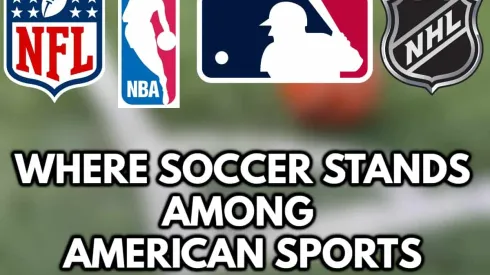
Indisputably, soccer is the world’s most-popular sport. But is it the 4th most popular sport in the United States?
The beautiful thing about soccer is that it extends beyond just one league. Taken as a whole, the sport is bigger than ever before. In spite of this, it is no secret that MLS pales in comparison to the major European Leagues. Those leagues have devout fanbases stateside. Having said that, Liga MX garners even more support than MLS and the Premier League.
For instance, in 2018, the Liga MX final pulled in almost 5 million viewers combined over two legs. Each game averaged around 2.5 million viewers, more than MLS. Such is the nature of the diverse culture persisting in the United States.
As stated above, European leagues also rake in consistently large numbers. For example, the Premier League, the most-followed European league in the U.S., averages numbers that rival American leagues. Over the last three seasons, the Premier League averaged roughly 450,000 viewers per game. While the NBA and NFL pull in larger audiences, these are national broadcasts on primetime that we get the numbers for. It is important to consider things like kickoff times, broadcast locations and overlapping fixtures when looking at Premier League viewership.
READ MORE: How kickoff times influence soccer viewership in the U.S.
This also ties into the growth. The NFL and NBA over the aforementioned period of time showed dropping audiences. While the Premier League viewership in the U.S. dipped in 2020/21, there is consistent developments over the last decade.
Yes, the beauty of soccer is that it extends beyond one league. However, it also makes it more difficult to compare it against other sports. If Liga MX, Premier League, MLS and LaLiga numbers were combined into one soccer “entity,” how would it compare? And what metrics would be used to compare the popularity? TV viewing numbers alone aren’t enough. It’s a combination of various metrics.
Let’s take a closer look.
How Soccer is the 4th most popular sport
Ask most Americans on the street to name the top four sports in this country. Chances are it will be the same answer. Football, basketball, baseball and hockey.
We have heard that same top four so many times that it is ingrained in our sports culture. For instance, watch any sports talking heads show on ESPN, FOX or a different broadcaster. That top four list of football, basketball, baseball and hockey is again beaten into our brains. Not surprisingly, soccer is largely ignored on these shows.
However, what they — and many fútbol fans — may not realize is that soccer has eclipsed hockey. Soccer is the fourth most favorite sport to watch among American adults, according to Gallup. Not only that, but soccer is breathing down the neck of baseball. In that same Gallup poll, baseball’s two percent lead over soccer is the slimmest margin that a third spot has held over fourth in the last 20 years.
Furthermore, the average age of a baseball fan is 57 and rising. With soccer, it’s 35. In the same manner, nearly 70 percent of soccer fans in America are younger than 40 years old.
Moreover, soccer is the second most popular sport in the United States among Americans aged 12-24. Baseball ranks number five among that age group.
Just as important, soccer is making huge gains among Hispanic Americans and younger viewers. Firstly, soccer is the most popular sport among Hispanic Americans aged 12-24. Secondly, the sport of soccer is also increasingly popular among Americans aged 6-17. In fact, eleven percent of the TV audience who watch Premier League soccer on NBCSN are kids 6-17, compared to only 4.6% of World Series audience, 9.4% of NBA Conference Finals audience and 9% of NHL Conference Finals.
What these numbers tell us is that soccer has broken the top four glass ceiling. It is now the 4th most popular sport. Equally important, soccer will become the third most popular sport in the near future.
In fact, LAFC lead managing owner Larry Berg boasted this in 2020: “I think [MLS] definitely have the demographics in our favor in terms of youth and diversity. I think we’ll pass baseball and hockey to be the number three sport in the U.S. behind football and basketball.”
Playing the game
The global nature of soccer and its relative ease of access means it persists in other avenues as well.
For example, simply playing the sport. There are a multitude of reasons that children in the United States avoid certain sports. Concussions largely push parents and children away from American football. Soccer is not immune to that, perhaps that is why we see modified regulations regarding heading for children in youth soccer.
Comparatively, soccer ranks third in terms of most-popular team sports for children aged 13 to 17. Basketball and Baseball are the only two higher, with soccer edging out tackle football. The one caveat is that the survey, conducted by the Aspen Institute, is that flag football and tackle football are counted separately. Combined, American football ranks third.
Soccer may sit behind baseball, basketball and football, but it is comfortably in front of ice hockey, field hockey and lacrosse. Lacrosse and soccer are certainly growing among American youth. However, as things stand, soccer is firmly the 4th most popular sport in terms of popularity.
Baseball is slipping, in more ways than one. As Aram Gumusyan reports:
Baseball is becoming more of a regional sport than a national sport. The World Series was once the 2nd-most watched team sports championship in America. But the NBA Finals average audience beat the World Series in 9 of the past 10 years.
Quantity of soccer games a big factor
According to Nielsen, soccer garnered the most engagements based on traditional and digital viewership. For example, among each major sports league, soccer occupied four of the top-five leagues in terms of broadcast hours. Due to soccer’s enormous and diverse fanbase, LaLiga, the Premier League, the Bundesliga and the Champions League pushed out more content than almost any other sports league. The one exception came from the NBA, which sat in third in terms of broadcast hours.
Digitally, soccer leagues remain at the top. In terms of followers, the Champions League, LaLiga and the Premier League rank in the top-four. Once again, the NBA reaches the number-three spot in the rankings.
However, while these leagues dominate in terms of follower count or broadcast hours, they remain relatively average in terms of growth. Of course, it is hard to grow a league that already has an extensive reach.
MLS making a difference too
One league going under relatively strong growth is Major League Soccer.
Generally, American populations look at MLS as a subpar league, something not up to the standard of the European game. Ergo, smaller crowds show up, less people care about in on social media and it warrants less recognition than other sports.
In the United States, there is a traditional big-four. The National Football League, the National Basketball Association, Major League Baseball and the National Hockey League are widespread leagues that receive considerable followings.
Historically, sure, these are the four most popular leagues in the United States. Few would argue with the pedigree of the NFL, the NBA and Major League Baseball. However, in the modern era, soccer edges hockey as the fourth member of that illustrious club in the United States.
MLS influence on 4th most popular sport?
It can be hard for soccer in the United States to compare with such a drastically different timeline. The NBA began 75 years ago. The NFL, or at least the leagues that became the NFL, started just over 100 years ago. The NHL played its first season not long before then at 103 years ago. Major League Baseball holds the honor of being the oldest league, starting way back in 1903. However, the National League dates back 27 years before then.
Comparatively, Major League Soccer is young. While other leagues came and went, notably the National American Soccer League, Major League Soccer continues to grow. Starting in just 1996, MLS was the new league established after the 1994 World Cup in the United States.
Despite its public-thought not living up to the popularity of its competitors, the league has a solid, and growing home, across the country.
In fact, if we use the same Nielsen ratings as before, we see the MLS is actually one of the world’s, not just the country’s most popular leagues. Moreover, it shows that the MLS is fast-approaching the National Hockey League. First off, the cumulative reach of different leagues favors the NHL. Comparatively, the NHL has a cumulative reach of 359 million. However, according to Nielsen, 55 percent of that reach comes from China, where the NHL leads all U.S. events.
Personally, I cannot explain that phenomenon. The NBA’s circumstances with China prevented the league from airing in the country for the 2020 season. Certainly, that contributed to the NBA’s low reach, and perhaps it expanded that of the NHL.
In terms of broadcast hours, the MLS exceeds the NHL despite having less teams and less games played per season.
Growth
It is great having large numbers, but executives and fans alike still want more. Whether that be more fans following teams or more games played, there is seemingly endless potential.
Fortunately for American soccer fans, MLS shows considerable growth over the last decade. Entering the 2019 season, MLS experienced a 27% rise in interest since 2012, according to Nielsen Sports Sponsorlink. Moreover, stadium attendance continues to rise. Since 2009, the average attendance of MLS games jumped by over 6,000 up to 2017. Similarly, the average percentage of capacity during MLS games moved from 70% to 93% on that same span.
Top-four league in the U.S.?
If we base popularity on capacity at stadiums, MLS would rank second or third behind the NFL and MLB. Of course, that is only because these two sports take place outside. As a result, the relatively smaller, indoor capacities of NBA and NHL are a reason why they are not higher.
A better look would be at average capacity percentage. As seen previously, the average percentage capacity entering the 2019 MLS season was 88.3 percent. Clubs like Atlanta United and Orlando City, both of which are relatively young clubs, helps that trend. Comparatively, the NHL averaged 96.1 percent capacity in 2019/20, the NFL hit 95.15 percent, NBA at 95.2 and MLB struggled to just 66 percent capacity.
Few would argue MLB is smaller than MLS. There is so much more than stadium capacity that goes in to popularity. For instance, the 2020 World Series represented the least-watched Fall Classic over the last near-60 years. The six games between the Tampa Bay Rays and Los Angeles Dodgers yielded an average TV audience of 11.35 million people in the United States. The NHL, generally considered the smallest of the big-four leagues in the U.S., pulled in an average of 2.15 million viewers as the Tampa Bay Lightning defeated the Dallas Stars in six games. On the other hand, the 2020 MLS Cup Final brought in 1.071 million viewers on FOX. Moreover, that number shows a 30 percent jump from the 2019 final.
Right now, MLS may not be as big as the other four leagues. That’s fair, but that is not necessarily the aim of this story.
Rather, soccer as a sport is bigger than hockey in the United States. In conclusion, it is officially the 4th most popular sport. Baseball, watch out.














